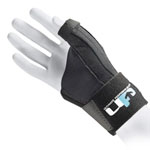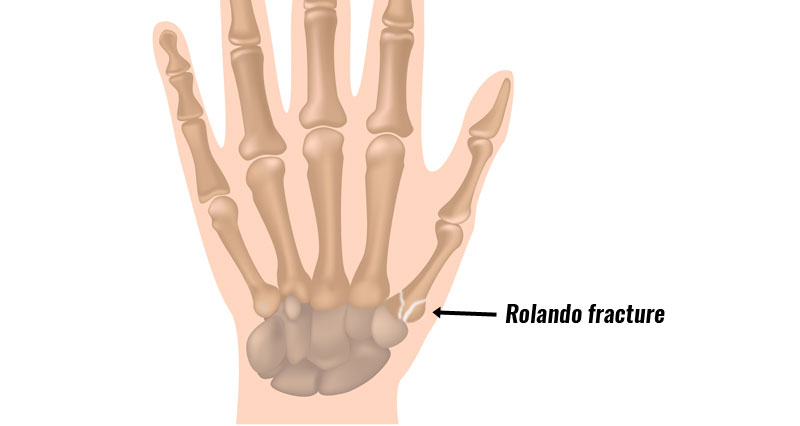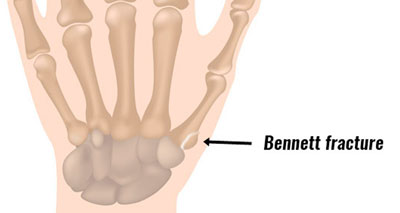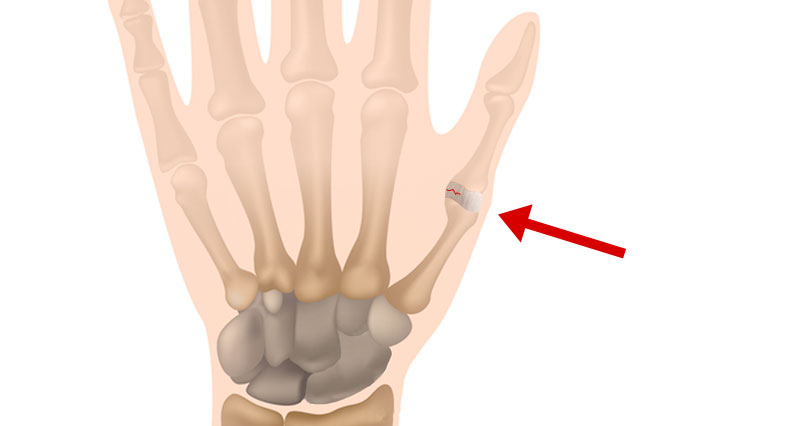A broken thumb is either a break to the small phalanges bones which make up the thumb. Or a fracture at the base of the thumb, where it attaches to the metacarpal bone in the hand. Fractures at the base are known as Bennett fractures or Rolando fractures.
Symptoms of a broken thumb
- Symptoms include sudden pain at the time of injury with immediate swelling and bruising that will come on rapidly.
- The thumb will be particularly painful when attempting to move it.
- Your thumb may click during movement.
What is a Thumb fracture?
Thumb fractures are not very common. This is because:
- The bones (phalanges) are thicker than those in the fingers.
- The thumb is opposable and shorter than the finger Therefore, it is often protected by bringing it across the palm of the hand.
A simple fracture to one of the phalanges is relatively straightforward to treat and heals well. A break which is close to the end of the bone, near the base of the thumb is more common. It is also more difficult to treat, often requiring surgery.

Thumb Supports
Bennett fracture & Rolando thumb fractures

This is especially true of the Bennett fracture and the Rolando fracture which occur at the joint between the 1st metacarpal and the wrist. Both a virtually the same, except with a Rolando fracture, the bone breaks into more than two pieces.

In sports, many thumbs and finger fractures can be prevented by wearing the appropriate protective wear, such as gloves, padding, or taping.

Thumb Supports
Treatment of a broken thumb
If you suspect a thumb fracture, especially a Rolando, or Bennett’s fracture at the base of the thumb then seek medical attention as soon as possible.
Initial treatment of a suspected thumb fracture is to immobilise with a splint and apply ice or cold water to reduce pain and swelling.
Your hand should be raised up high above the heart to ensure gravity helps with reducing bleeding and swelling.
A Doctor will examine your hand for signs of any complications such as nerve or blood vessel damage. They will also perform an X-ray to confirm the diagnosis and check the fractured piece of bone is not displaced.
If it is a simple fracture that has not become displaced, the thumb may be immobilized in a thumb spica cast. This goes from the forearm to the hand and continues onto the thumb. Therefore, immobilizing the entire thumb joint.
The cast is kept on for 3 to 6 weeks depending on the patient’s age. Younger patients will heal quicker. In some cases, a more lightweight splint may be used.
Surgery
In more complicated cases where there is more than one fragment or the bones are displaced, then surgery may be necessary. The surgeon may realign the fragments and fix them in place with pins.
The thumb is again immobilized for several weeks. After the immobilization period, thumb exercises should be performed to help regain full strength and movement. Hand therapy putty and elastic bands are particularly good for this.
External links
- Buy Thumb stabiliser at UPMedical.co.uk


